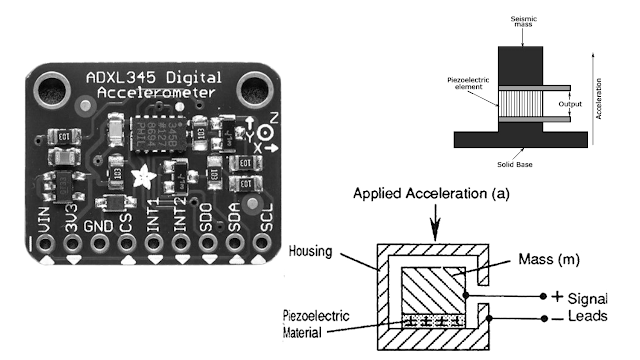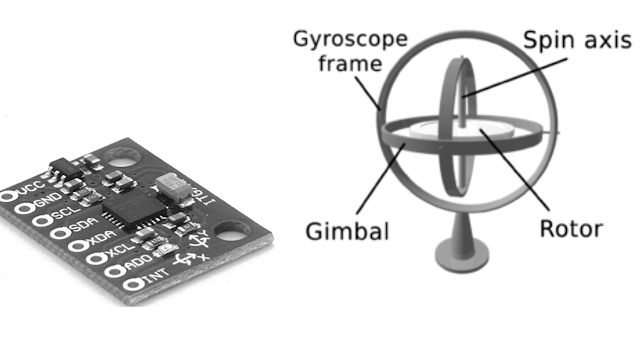Accelerometers & Gyroscope Sensor
Accelerometers & Gyroscope Sensor
Accelerometers sensor
Accelerometer
An accelerometer is an electro- mechanical device that measures proper acceleration forces. These forces may be static like the constant force of gravity pulling at your feet, or they could be dynamic – caused by moving and vibrating the accelerometer.
Principle
The working principle of an accelerometer is based on PIEZO-ELECTRIC EFFECT (due to accelerative forces) and on the DISPLACEMENT SENSING (based on displacement of mass).
How it works
In most of the cases working of an ACCELEROMETER is based on voltage generation and its further calculations which leads to the determination of acceleration where as some other involve the measurement of displacement of mass.
Types of accelerometer
There are basically two types of accelerometer frequently used for measurement of acceleration
Piezo electric accelerometer
Displacement sensing or seismic type accelerometer
It employs the piezo electric effect of certain materials to measure dynamic changes. It converts one form of energy into another and provide electrical signal of measured amount.
Working Principle
The working principle of this is based on “NEWTONS THIRD LAW” . The force exerted on the material can be observed in the change in the electrostatic force or voltage generated by the piezoelectric material.
Fastened on the base which act as a spring and squeezes the mass against crystal for acceleration determination.
Leads to voltage generation and fluctuation in voltage leads to measurement of imposed acceleration.
Sensor consist of piezoelectric crystal sand witched between two electrodes with a mass placed on it
Advantages
- Rugged and Inexpensive
- High Impedance
- High sensitivity
- High frequency response
Disadvantages
- Sensitive to temperature
- Hysteresis error
- Less longevity
- Decreased efficiency with time
Seismic accelerometer
In displacement sensing accelerometer the displacement of a mass resulting from an applied force is measured and correlated to the acceleration .Here a common spring – mass-damper system which accomplishes the task of acceleration measurement through displacement.
Working Principle
The working principle of this is based on mass-spring-damper combination and similarly acceleration calculation from displacement.
The mass is supported by a spring and connected to the housing frame which is attached to a machine.
Relative mass movement is sensed and indicated by an electrical displacement transducer.
Correspondingly displacement and velocity are measured and further acceleration are measured.
Advantages
- Easy Calculation
- Simple and reliable
- Durable and efficient
Disadvantages
- Spring system is not always accurate
- Fluctuation in mass leads to wrong calculation.
Application of Accelerometer
- Acceleration and vibration calculation in vehicles
- In industries for monitoring machines
- Building and structural monitoring
- Medical application and navigation
- Transport
Gyroscope sensor
What is a gyroscope?
Definition :
A gyroscope is a device for measuring or maintaining orientation, based on the principles of conservation of angular momentum.
Properties of gyroscopes
Gyroscopes have two basic properties: Rigidity and Precession These properties are defined as follows:
Rigidity: The axis of rotation (spin axis) of the gyro wheel tends to remain in a fixed direction in space if no force is applied to it.
Precession: The axis of rotation has a tendency to turn at a right angle to the direction of an applied force
Types of Gyroscopes available
Spinning Mass Gyro
Mass spins steadily within the gyro with free movables axis (gimbals).
Optical Gyroscope
Laser rays reflect many times within an enclosure, any changes in orientation will be registered as changes between the moment of the laser emittance to eventual reception.
Vibrating Gyroscope
Determines rate of turn by a vibrating resonator and its change in vibrations from the original vibrating direction.
Gas Rate Gyro
Sprays gas on heated coils, when a change in direction occurs the spray is curved resulting in a change in the temperature of the coils. (Currently unpractical because of the numerous factors involved
Mechanical Gyroscope
A mechanical gyroscope is essentially a spinning wheel or disk whose axle is free to take any orientation. This orientation changes much less in response to a given external torque than it would without the large angular momentum associated with the gyroscope's high rate of spin.
Applications of Gyroscopes
A. In Aeronautics and Aviation
- Remote control flying devices, helicopters, some hovercraft, some planes, etc. rely on gyroscopes to prevent them from flipping over or going into a spin.
- Spacecraft rely on gyroscopes for orientation while in space.
- Aircraft and aircraft autopilots rely on gyroscopes to account for changes in direction & altitude
B. In Naval field
- Gyroscope are used in ships to maintain stability as the effect of gyroscopic couple is on
- Steering
- Pitching
- Rolling
C. In automobiles
- Gyroscopic behaviour is used in the racing car industry. This is because car engines act just like big gyroscopes. Because of the of the gyroscopic forces from the engine depending on whether the engine is spinning clockwise or anti-clockwise the cars nose will be forced up or down.
- Wheels on motorbikes act as gyroscopes and make the bike easier to balance (stay up right) when moving.
D. In toys and everyday uses
- Gyroscopes are used in various toys such as yo-yos and Frisbees. Some other toy products are Gravitron and ChikyuGoma.
E. In electronics and gadgets
- Gyroscopes are used in various fields nowadays such as in smartphones, video game controllers, computer mouses and presentation mouses.



Comments
Post a Comment